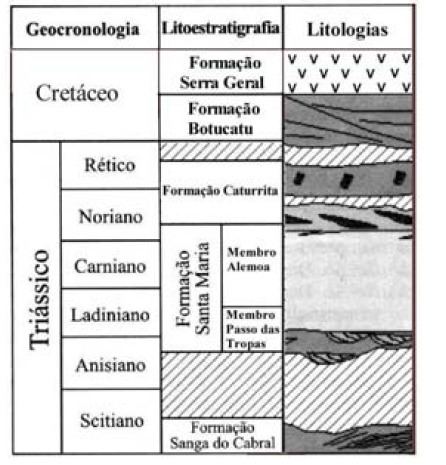Type Geological formation Thickness 30 - 60 m | Coordinates -29.695042, -53.795403 Primary Sandstone, Siltstone | |
 | ||
Region Paleorrota Rio Grande do Sul | ||
The Caturrita Formation is a rock formation found in Rio Grande do Sul, Brazil. Its sediments were deposited in the Paraná Basin. The formation most likely has a late Carnian to early Norian age (Upper Triassic) and forms part of the Santa Maria Supersequence in the upper section of the Rosário do Sul Group.
Contents
Etymology
The formation received this name, because Caturrita is a neighbourhood (barrio) of Santa Maria. In Portuguese caturrita also refers to the monk parakeet.
Stratigraphy
The sediments of the Caturrita Formation belong to the second unit of the Santa Maria Supersequence and overlie the Alemoa Member of the Santa Maria Formation. The clayey sediments of the Alemoa Member gradually give way to the more sandy, rarely conglomeratic, Caturrita Formation, which finishes with an unconformity. After this erosional event follow the Rhaetian sediments of the Mata Sandstone, the third unit of the Santa Maria Supersequence.
The Caturrita Formation was once regarded as a member of the stratigraphically higher Botucatu Formation or was expanded to include the Mata Sandstone.
The Caturrita Formation reaches a maximum thickness of 60 meters, but generally oscillates around values of 30 meters.
Age
So far no absolute ages have been determined, but the formation is most commonly assigned to a late Carnian to early Norian age on paleontological grounds, i.e. an age range of about 220 to 215 million years BP. However, Rhaetian or even Early Jurassic age of this unit was also advocated in the literature.
Geographical occurrence
Outcrops of the Caturrita Formation are found in the Brazilian state of Rio Grande do Sul. From the town of Taquari they follow for 250 kilometers a thin band in the central part of the state in an east-westerly fashion right up to Mata.
Depositional environment
The sediments of the Caturrita Formation belong to the upper section of the Santa Maria Supersequence. In terms of sequence stratigraphy they are equivalent to a highstand systems tract. The scarlet, ephemeral, mainly clayey fluvio-lacustrine deposits of the Alemoa Member gradually cede to more sandy, occasionally gravelly deposits of a braided river-system that was operational all-year-round. These deposits of the Caturrita Formation settled out in an alluvial flood-plain. The changeover in sedimentary facies was accompanied by a climatic change to more humid conditions.
The sediments are of continental nature (red beds) and form massive sandstone and siltstone bodies.
Vertebrate fauna
The Caturrita Formation contains a biozone for tetrapods, the so-called “Ictidosauria Assemblage Zone″ Ca-1.Ictidosaurs are trithelodontid cynodonts, a sister group of the mammals. This is the reason, why this biozone recently has been renamed as “Mammaliamorpha Cenozone” to underline the importance of the cynodont fossils. The Caturrita Formation also hosts the stratigraphic marker level “Jachaleria” named after the dicynodont Jachaleria candelariensis. Dinosaurs and other vertebrates have been discovered as well.
In 1998 tracks of prosauropods have been found near Faxinal do Soturno that were most likely caused by Unaysaurus tolentinoi.
The fossil finds are concentrated around three major areas: Santa Maria and northern surroundings (Água Negra) Faxinal do Soturno Candelária and surroundings (Linha São Luis)
The following taxa have been discovered so far in the Caturrita Formation:
Dinosaurs
Unnamed prosauropod genus present in Rio Grande do Sul, Brazil.
Other tetrapods
Undetermined phytosaur genus.
